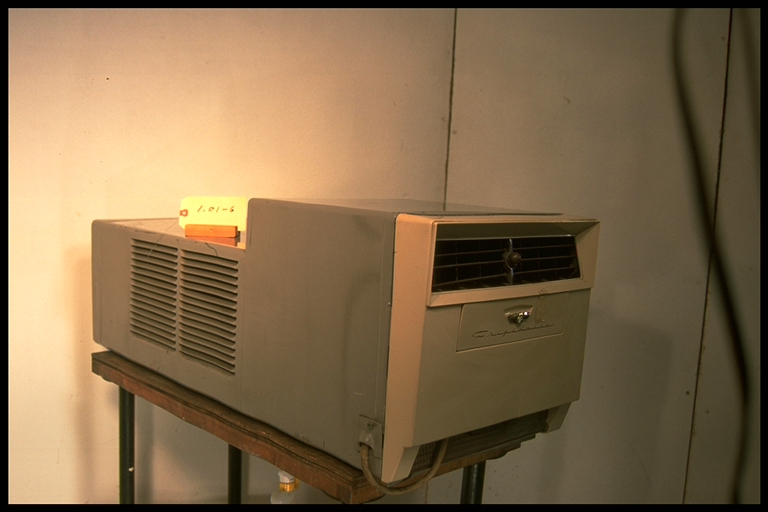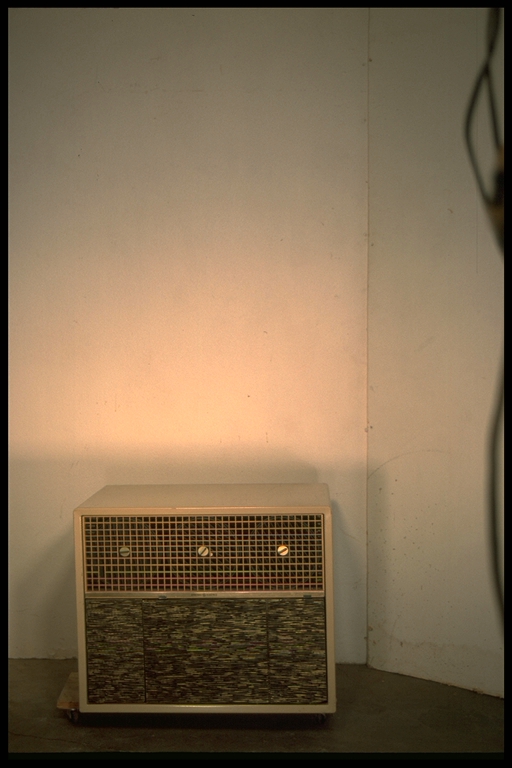1.02-1: Frigidaire 1955 Through-The-Window, Room Air Conditioner

| HHCC Accession No. 2003.006 | HHCC Classification Code: 1.02-1 |
|---|
Description:
Household, Through-the-Window, Room Air Conditioner, Frigidaire, 1956
Group:
1.02 Unitary Refrig. and A/C Equipment and Systems - Household Air Conditioners
Make:
Frigidaire
Manufacturer:
Frigidaire Products Canada Ltd, Scarborough, Ont
Model:
Super 33
Serial No.:
50Y2859
Size:
15x 36x 13.5’
Weight:
115 lbs
Circa:
1955
Rating:
Exhibit Quality, excellent example of the gendre, fully operational, new and unused
Patent Date/Number:
Provenance:
From York County (York Region) Ontario, once a rich agricultural hinterlands, attracting early settlement in the last years of the 18th century. Located on the north slopes of the Oak Ridges Moraine, within 20 miles of Toronto, the County would also attract early ex-urban development, to be come a wealthy market place for the emerging household and consumer technologies of the early and mid 20th century.
This artifact was discovered in the 1950’s in the used stock of T. H. Oliver, Refrigeration and Electric Sales and Service, Aurora, Ontario, an early worker in the field of agricultural, industrial and consumer technology.
Type and Design:
A household, unitary, room air conditioner designed for through the window applications, in which the heat is rejected to the exterior of the home by means of a forced air condenser. The air conditioner operating system employs the compression refrigeration cycle operating on a theoretical Carnot cycle
Construction:
Material:
Special Features:
Automatic temperature control, Outside fresh air damper Air filter Complete, original installation kit
Accessories:
: Full text sales, application and engineering design manuals included.
Capacities:
This air conditioner, 1/3 HP in capacity, was minimum for useful household cooling. Designed for a small bedroom, it would provide the taste for the latest appliance of the times, helping to build market demand. It was in the 1950’s that the leading principle of consumer economics began to be popularly recognised ‘ i.e., demand is generated by the means by which it is satisfied, consumption.
Performance Characteristics:
Operation:
Control and Regulation:
Targeted Market Segment:
The household air conditioning business was still in its infancy in Canada in 1955, with many predictions that it would go nowhere. It would be difficult to have anticipated that by the end of the century few homes in the urban areas of southern Ontario would be built without central summer air conditioning.
The window air conditioner was thus a harbinger, an early market indicator of what was to come. The single room, through the window air conditioner, was an essential part of the first wave of air conditioning engineering for the home, allowing the industry to develop the equipment design, application protocols and standards and test the interest of the market place for what might follow.
Consumer Acceptance:
Merchandising:
Market Price:
Technological Significance:
Unitary Refrigeration Equipment: The idea of a unitary piece of refrigeration or air conditioning equipment was a significant one in its own right, one that had to wait its time. The scientists, engineers and inventors in the early years of the 20th century were intrigued and obsessed with the power of the technology and of its possible market potential. What they saw was the newly discovered principles of physics and heat engines - following, for example, the early works of Carnot, Faraday, Kelvin, and the later work of Perkins, Larsen and Carrier, to name a few.
They understood the promise of the technology for the public good, not to say its consumer sales potential. Early engineering work advanced on a multiple fronts with development of compressors, heat exchangers, valves and piping variously strung together in configurations that would be found to work, but only after much experimentation.
The arrival of unitary equipment, all those parts organised into a single whole, a single unit of construction, a ‘black box’, that could be offered to the consumer market was a significant technological and cultural event. Technologically the refrigerator would need to be seen to be safe, reliable, maintainable and useful. As well, in order to attract the development capital needed, it must be seen as potentially saleable and affordable, contributing to life’s needs and desires. Its socio- cultural and economic significance was marked, for it would change much. As Canadians we would quickly come enjoy potentially healthier lives, expect new levels of comfort and convenience, with a broader, safer, more diverse and enjoyable diet.
Canadians would quickly come to think of their day differently, for the day would be defined and punctuated in different ways than ever before, as a result of the introduction of modern, electric, household appliances, of which refrigerators, freezers and room air conditioners would be a central part, by the mid 20th century
J. M Larsen produced a manually operated household refrigerator of sorts in 1913, but it was not until 1918 that the Kelvinator Company marketed the first automatic, unitary refrigerator for the home. In that year, it is reported to have sold sixty-seven machines. (See Note 1) The historic artifacts in Group 1.00, Unitary Equipment, including significant samplings the early work of Kelvinator of Canada, provide a rare view of the evolution of unitary refrigeration and air conditioning applications, as they evolved in Canada in the first half of the 20th century.
For those formative years, the artifacts in this Group, 1.00, are typical of the offerings of the Canadian refrigeration and air conditioning industry. They personified the applications found in the homes, farms and commercial premises of the period for, those that could afford life’s new amenities of comfort, convenience and privilege.
This Specimen stands as a marker of the embryonic years of household air conditioning in Canada. While vastly under powered, by the standards that would follow, it was for most urban dwellers affordable and a significant market opener.
Industrial Significance:
The development of high heat transfer, capacity compressors, condensers, evaporators and flow control devices, at a price that home owners were likely to find affordable, would be a major challenge and success story for the refrigeration industry in the early years of home air conditioning. The industry would quickly adapting what had been learned in the design of reliable hermetic compressors and coiling for the food industry to high heat transfer systems required for household air conditioning applications.
Suddenly the refrigeration and air conditioning industry expanded dramatically with a number of new non-traditional players designing, manufacturing and marketing equipment for household and commercial applications. In the face of increasing competition from manufactures with massive engineering and production facilities, many of the traditional suppliers to the refrigeration field would quickly fade from their earlier position of market leadership, including Kelvinator and Frigidaire.
Socio-economic Significance:
Socio-cultural Significance:
The room air conditioner, window mounted, stands as a significant icon of social and cultural change in 20th century life in Canada. Starting in the mid 1950’s, it would soon change the expectations of Canadians of the comfort conditions technology had now made available for all those who valued it and could afford the comfort of summer air conditioning.
Donor:
G. Leslie Oliver, The T. H. Oliver HVACR Collection
HHCC Storage Location:
Tracking:
Bibliographic References:
Frigidaire Air Conditioning Product Memos 1956 [manual]
